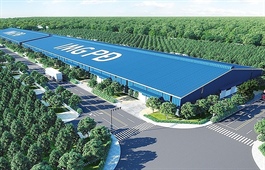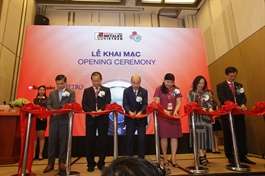Leveraging mobile connectivity for smarter factories
Leveraging mobile connectivity for smarter factories
Ericsson expects over two-thirds of the world’s manufacturing sites to reside in Asia by 2025, with Vietnam increasingly becoming a major manufacturing and investment hub for multinational companies.

By Denis Brunetti-President in Vietnam, Myanmar, Cambodia and Laos, Ericsson
|
Through Industry 4.0 and enabled by 5G technology, factories will become more efficient and productive across Vietnam, driving labour productivity growth rates of over 7 per cent per annum by 2025.
In factories today, wired connections are not optimal to modernise the factory floor. Hard-wired connections rely on fixed locations and equipment that require expensive cable installation to upgrade or meet factory extensions. While we expect that Wi-Fi and cellular will coexist for a while, Wi-Fi technology often falls short in reliability, security, and device density. To address most pain points and gain value in plant operations, the connectivity foundation must be as secure, reliable, and future-proof as possible.
Hence, a viable alternative to fixed connections is mobile technology such as 5G. The advantages of mobile networks are mitigation of bottlenecks, improved flexibility, and streamlined production. Mobile networks enable mobility, reliability, security, and a high device density, which refers to the number of connected devices per square metre. 4G, with a clear path to 5G, can yield significant operational cost savings for an upgraded smart factory.
Deploying Industry 4.0 solutions supported by a dedicated mobile network can generate an operational cost savings return on investment of 10-20 times over five years. 5G shows great promise as a single infrastructure so powerful that it can serve massive, critical, and industrial automation use cases. In the context of Industry 4.0, connectivity and seamless access to operational data are vital, because they effectively enable adoption of applications, such as asset tracking, and wireless connected robots.
There are multiple ways to “connect” a factory, but most communication on the manufacturing floor today is enabled by fixed connections or Wi-Fi. Neither of these technologies are optimal because wired connections require machines and sensors to be tethered to a specific location, among other reasons. This means that new connections and large factory extensions require cable runs that may cost thousands of dollars to install. ABI Research estimates cabling to represent 70-80 per cent of connectivity installation costs, which includes hardware and labour installation costs.

RGB With our combined IoT and 5G you will get the xfactory
|
By contrast, mobile connectivity is governed by a global value chain that conforms to a single standard. In addition to this, cellular networks enable mobility, reliability, security, and a high device density compared to any other communication standard. They are enabled by a value chain that has reached economies of scale for many years, translating to cost-effective device and connectivity module costs. 4G solutions are available, enabling factories to implement many of the use cases today. Industry 4.0 and 5G are beginning to enable applications like condition-based monitoring, asset tracking, and mobile robots.
Manufacturing plant owners can deploy the first version of dedicated mobile networks for simple use cases today and upgrade when this new functionality becomes available. Currently, the use of dedicated 4G networks in factories and warehouses in various markets supports the deployment and connection of an increasing number of devices and applications with different bandwidth requirements. Dedicated 4G is a wise first step towards 5G, allowing enterprises to gather experience in managing mobile networks.
Among manufacturers, there is an increasing trend to transition to 5G-ready dedicated networks to enable intelligent manufacturing, and Ericsson provides the expertise required. Most recently, ABB Power Grids in Sweden has also connected cordless screwdrivers in their manufacturing site. Scania, Europe’s largest manufacturer of trucks and buses, has piloted projects at their Smart Factory Lab to explore how 5G technology can be introduced in their production.

Industry robots automation automotive manufacturing
|
Another example includes Atlas Copco Airpower, a world-leading manufacturer of compressors, vacuum solutions, generators, pumps, power tools, and assembly systems. As an innovative manufacturer, efficient operations are essential, and Atlas Copco collaborates with Ericsson and Orange Belgium to ensure intelligent manufacturing with 4G and 5G. Atlas Copco has already made strides in their digital transformation journey and is a leading example for industrial actors in smart and flexible manufacturing.
While testing 5G technology, we have adopted it and digitalised Ericsson’s own production operations. With Nordic telecom operator Telia, we have brought automated guided vehicles, augmented reality, and a huge number of sensors to our manufacturing facility in Estonia via a dedicated cellular network. In the US, our first fully-automated smart factory is powered by Ericsson 5G solutions that support agile operations and flexible production.
ABI Research has predicted that there will be 4.3 billion wireless connections in smart factories by 2030, deployed to enable over $1 trillion in production value. Most of these connected endpoints are entirely new, such as autonomous mobile robots, cooperative robots, smart glasses, and industrial PCs, among others, which would benefit from cellular connectivity. Thus, the application of smart production will serve to help businesses save costs on production and logistics, while enhancing quality.
By wisely focusing on science, technology, and innovation while embracing Industry 4.0 through 4G and 5G capabilities, Vietnam is well on its way to creating a digital ecosystem that will attract high-tech foreign direct investment as well as drive inclusive and sustainable socioeconomic development.






















